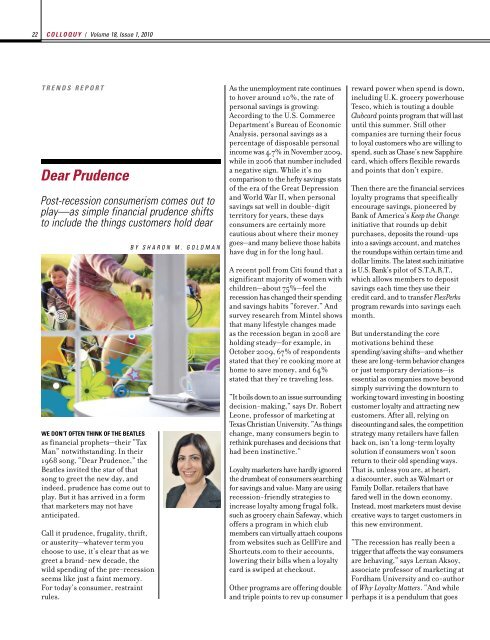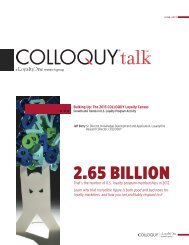Transformers - Colloquy
Transformers - Colloquy
Transformers - Colloquy
Create successful ePaper yourself
Turn your PDF publications into a flip-book with our unique Google optimized e-Paper software.
22<br />
C O L L O Q U Y / Volume 18, Issue 1, 2010<br />
T R E N D S R E P O R T<br />
Dear Prudence<br />
Post-recession consumerism comes out to<br />
play—as simple financial prudence shifts<br />
to include the things customers hold dear<br />
WE DON’T OFTEN THINK OF THE BEATLES<br />
as financial prophets—their “Tax<br />
Man” notwithstanding. In their<br />
1968 song, “Dear Prudence,” the<br />
Beatles invited the star of that<br />
song to greet the new day, and<br />
indeed, prudence has come out to<br />
play. But it has arrived in a form<br />
that marketers may not have<br />
anticipated.<br />
Call it prudence, frugality, thrift,<br />
or austerity—whatever term you<br />
choose to use, it’s clear that as we<br />
greet a brand-new decade, the<br />
wild spending of the pre-recession<br />
seems like just a faint memory.<br />
For today’s consumer, restraint<br />
rules.<br />
B Y S H A R O N M . G O L D M A N<br />
As the unemployment rate continues<br />
to hover around 10%, the rate of<br />
personal savings is growing:<br />
According to the U.S. Commerce<br />
Department’s Bureau of Economic<br />
Analysis, personal savings as a<br />
percentage of disposable personal<br />
income was 4.7% in November 2009,<br />
while in 2006 that number included<br />
a negative sign. While it’s no<br />
comparison to the hefty savings stats<br />
of the era of the Great Depression<br />
and World War II, when personal<br />
savings sat well in double-digit<br />
territory for years, these days<br />
consumers are certainly more<br />
cautious about where their money<br />
goes—and many believe those habits<br />
have dug in for the long haul.<br />
A recent poll from Citi found that a<br />
significant majority of women with<br />
children—about 75%—feel the<br />
recession has changed their spending<br />
and savings habits “forever.” And<br />
survey research from Mintel shows<br />
that many lifestyle changes made<br />
as the recession began in 2008 are<br />
holding steady—for example, in<br />
October 2009, 67% of respondents<br />
stated that they’re cooking more at<br />
home to save money, and 64%<br />
stated that they’re traveling less.<br />
“It boils down to an issue surrounding<br />
decision-making,” says Dr. Robert<br />
Leone, professor of marketing at<br />
Texas Christian University. “As things<br />
change, many consumers begin to<br />
rethink purchases and decisions that<br />
had been instinctive.”<br />
Loyalty marketers have hardly ignored<br />
the drumbeat of consumers searching<br />
for savings and value: Many are using<br />
recession-friendly strategies to<br />
increase loyalty among frugal folk,<br />
such as grocery chain Safeway, which<br />
offers a program in which club<br />
members can virtually attach coupons<br />
from websites such as CellFire and<br />
Shortcuts.com to their accounts,<br />
lowering their bills when a loyalty<br />
card is swiped at checkout.<br />
Other programs are offering double<br />
and triple points to rev up consumer<br />
reward power when spend is down,<br />
including U.K. grocery powerhouse<br />
Tesco, which is touting a double<br />
Clubcard points program that will last<br />
until this summer. Still other<br />
companies are turning their focus<br />
to loyal customers who are willing to<br />
spend, such as Chase’s new Sapphire<br />
card, which offers flexible rewards<br />
and points that don’t expire.<br />
Then there are the financial services<br />
loyalty programs that specifically<br />
encourage savings, pioneered by<br />
Bank of America’s Keep the Change<br />
initiative that rounds up debit<br />
purchases, deposits the round-ups<br />
into a savings account, and matches<br />
the roundups within certain time and<br />
dollar limits. The latest such initiative<br />
is U.S. Bank’s pilot of S.T.A.R.T.,<br />
which allows members to deposit<br />
savings each time they use their<br />
credit card, and to transfer FlexPerks<br />
program rewards into savings each<br />
month.<br />
But understanding the core<br />
motivations behind these<br />
spending/saving shifts—and whether<br />
these are long-term behavior changes<br />
or just temporary deviations—is<br />
essential as companies move beyond<br />
simply surviving the downturn to<br />
working toward investing in boosting<br />
customer loyalty and attracting new<br />
customers. After all, relying on<br />
discounting and sales, the competition<br />
strategy many retailers have fallen<br />
back on, isn’t a long-term loyalty<br />
solution if consumers won’t soon<br />
return to their old spending ways.<br />
That is, unless you are, at heart,<br />
a discounter, such as Walmart or<br />
Family Dollar, retailers that have<br />
fared well in the down economy.<br />
Instead, most marketers must devise<br />
creative ways to target customers in<br />
this new environment.<br />
“The recession has really been a<br />
trigger that affects the way consumers<br />
are behaving,” says Lerzan Aksoy,<br />
associate professor of marketing at<br />
Fordham University and co-author<br />
of Why Loyalty Matters. “And while<br />
perhaps it is a pendulum that goes




